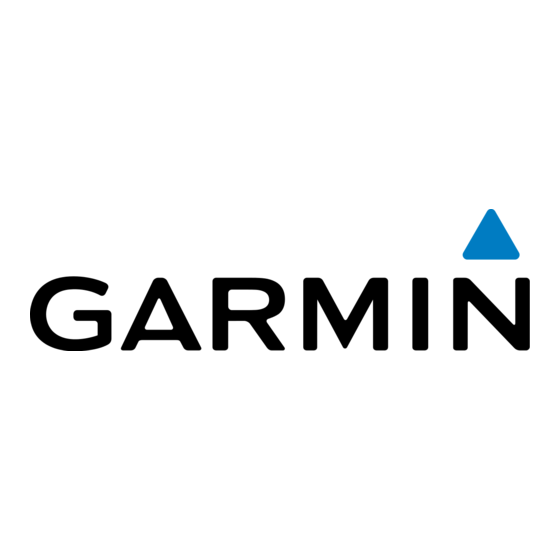Garmin ECHOMAP PLUS 70 series 소유자 매뉴얼 - 페이지 37
{카테고리_이름} Garmin ECHOMAP PLUS 70 series에 대한 소유자 매뉴얼을 온라인으로 검색하거나 PDF를 다운로드하세요. Garmin ECHOMAP PLUS 70 series 50 페이지.
Garmin ECHOMAP PLUS 70 series에 대해서도 마찬가지입니다: 빠른 시작 매뉴얼 (8 페이지), 설치 지침 매뉴얼 (6 페이지)

• The chartplotter can track the positions of vessels sending
position reports.
Turning On DSC
Select Settings > Other Vessels > DSC.
DSC List
The DSC list is a log of the most recent DSC calls and other
DSC contacts you have entered. The DSC list can contain up to
100 entries. The DSC list shows the most recent call from a
boat. If a second call is received from the same boat, it replaces
the first call in the call list.
Viewing the DSC List
Before you can view the DSC list, the chartplotter must be
connected to a VHF radio that supports DSC.
Select Nav Info > Other Vessels > DSC List.
Adding a DSC Contact
You can add a vessel to your DSC list. You can make calls to a
DSC contact from the chartplotter.
1
Select Nav Info > Other Vessels > DSC List > Add
Contact.
2
Enter the Maritime Mobile Service Identity (MMSI) of the
vessel.
3
Enter the name of the vessel.
Incoming Distress Calls
If your compatible chartplotter and VHF radio are connected
using NMEA 0183, your chartplotter alerts you when your VHF
radio receives a DSC distress call. If position information was
sent with the distress call, that information is also available and
recorded with the call.
designates a distress call in the DSC list and marks the
position of the vessel on the Navigation chart at the time of the
DSC distress call.
Navigating to a Vessel in Distress
designates a distress call in the DSC list and marks the
position of a vessel on the Navigation chart at the time of the
DSC distress call.
1
Select Nav Info > Other Vessels > DSC List.
2
Select a position-report call.
3
Select Navigate To.
4
Select Go To or Route To.
Position Tracking
When you connect the chartplotter to a VHF radio using NMEA
0183, you can track vessels that send position reports.
This feature is also available with NMEA 2000, when the vessel
sends the correct PGN data (PGN 129808; DSC Call
Information).
Every position report call received is logged in the DSC list
(DSC List, page
31).
Viewing a Position Report
1
Select Nav Info > Other Vessels > DSC List.
2
Select a position-report call.
3
Select an option:
• To view the position report details, select .
• To view to a chart marking the location, select .
Navigating to a Tracked Vessel
1
Select Nav Info > Other Vessels > DSC List.
2
Select a position-report call.
3
Select Navigate To.
Digital Selective Calling
4
Select Go To or Route To.
Creating a Waypoint at the Position of a Tracked
Vessel
1
Select Nav Info > Other Vessels > DSC List.
2
Select a position-report call.
3
Select Create Waypoint.
Editing Information in a Position Report
1
Select Nav Info > Other Vessels > DSC List.
2
Select a position-report call.
3
Select Edit.
• To enter the name of the vessel, select Name.
• To select a new symbol, select Symbol, if available.
• To enter a comment, select Comment.
• To show a trail line for the vessel if your radio is tracking
the position of the vessel, select Trail.
• To select a color for the trail line, select Trail Line.
Deleting a Position-Report Call
1
Select Nav Info > Other Vessels > DSC List.
2
Select a position-report call.
3
Select Edit > Clear Report.
Viewing Vessel Trails on the Chart
You can view trails for all tracked vessels on some chart views.
By default, a black line indicates the path of the vessel, a black
dot indicates each previously reported position of a tracked
vessel, and a blue flag indicates the last reported position of the
vessel.
1
From a chart or 3D chart view, select MENU > Layers >
Other Vessels > DSC > DSC Trails.
2
Select the number of hours to show tracked vessels on the
chart.
For example, if you select 4 Hours, all trail points that are
less than four hours old appear for all tracked vessels.
Individual Routine Calls
When you connect the chartplotter to a Garmin VHF radio, you
can use the chartplotter interface to set up an individual routine
call.
When setting up an individual routine call from your chartplotter,
you can select the DSC channel on which you want to
communicate. The radio transmits this request with your call.
Selecting a DSC Channel
NOTE: The selection of a DSC channel is limited to those
channels that are available in all frequency bands. The default
channel is 72. If you select a different channel, the chartplotter
uses that channel for subsequent calls until you call using
another channel.
1
Select Nav Info > Other Vessels > DSC List.
2
Select a vessel or a station to call.
3
Select Call with Radio > Channel.
4
Select an available channel.
Making an Individual Routine Call
NOTE: When initiating a call from the chartplotter, if the radio
does not have an MMSI number programmed, the radio will not
receive call information.
1
Select Nav Info > Other Vessels > DSC List.
2
Select a vessel or a station to call.
3
Select Call with Radio.
4
If necessary, select Channel, and select a new channel.
31
